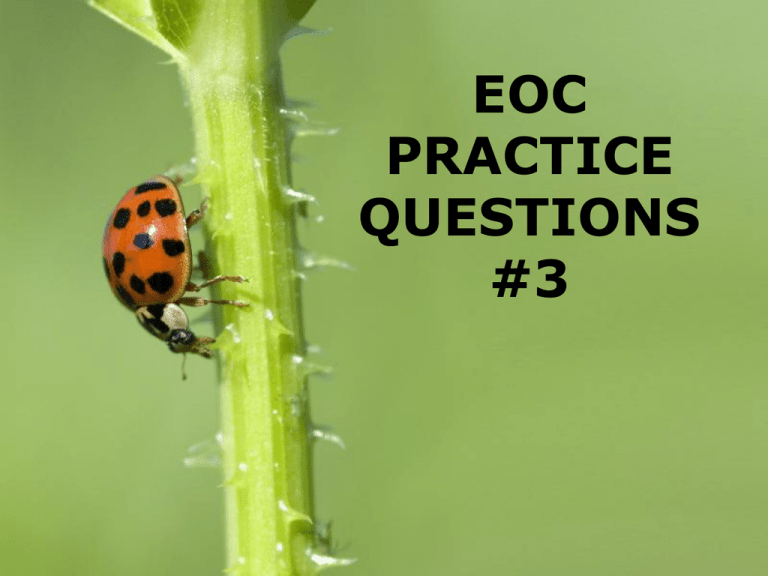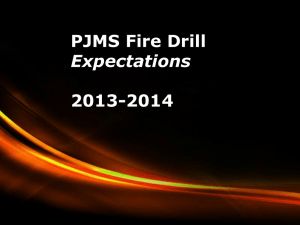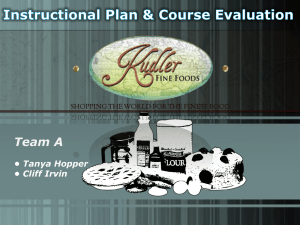Page - Wayne County Public Schools
advertisement

EOC PRACTICE QUESTIONS #3 Free Powerpoint Templates Page * Bio.3.4 - Explain the theory of evolution by natural selection as a mechanism for how species change over time. Free Powerpoint Templates Page * Change over time is called •evolution Free Powerpoint Templates Page * 4 evidences of evolution are •Biochemical (#1) •Fossil •Anatomical •Embryological Free Powerpoint Templates Page * The most primitive fossils are found in ______ layer. The more complex are in the _______ layer. - Bottom •Top Free Powerpoint Templates Page * Which shows a common ancestor? Homologous structures Free Powerpoint Templates Page * Structures that have no essential function are called ________. Examples are __(list5)___. •vestigial structures •Appendix •wisdom teeth •tonsils in humans •Tail bone ( coccyx ) •pelvic girdle and beginnings of femurs in whales Free Powerpoint Templates Page * Similarities in embryos of vertebrates show that the have a _________________. common ancestor Free Powerpoint Templates Page * Which primates share a common ancestor? Chimp Gorilla Human Free Powerpoint Templates Page * Darwin’s theory that those most adapt to the environment will survive and reproduce is called •Natural Selection (survival of the fittest) Free Powerpoint Templates Page * The 4 steps in Darwin’s theory are •1. Variation (due to sexual reproduction and other changes in the gene pool) Free Powerpoint Templates Page * The 4 steps in Darwin’s theory are •2. Overproduction (ensures species survival) Free Powerpoint Templates Page * The 4 steps in Darwin’s theory are •3. Competition(same habitat and niche) Free Powerpoint Templates Page * The 4 steps in Darwin’s theory are •4. Natural Selection (most adapt survive and their genes are passed onto their children) Free Powerpoint Templates Page * Label the graphs below. Directional Selection Free Powerpoint Templates Page * Label the graphs below. •Stabilizing Selection Free Powerpoint Templates Page * Label the graphs below. •Disruptive Selection Free Powerpoint Templates Page * Type of evolution in which similar organisms become different overtime due to their environments is called _______. Examples are : ___________. •divergent evolution or adaptive radiation •Darwin’s finches and turtles •whale and a human, both of which are mammals Free Powerpoint Templates Page * Type of evolution in which different organisms become more similar is called_______. Examples are: _____________. •convergent evolution •Fish and sharks, whales and dolphins, penguins and seals •(fish, aves –birds, mammals) Free Powerpoint Templates Page * _____ is when organisms adapt and evolve together to benefit their situation. Examples are: _________. •Coevolution •Arthropods (insects in this case) and angiosperms Free Powerpoint Templates Page * This diagram shows : _________. adaptive radiation or divergent evolution due to different environments Free Powerpoint Templates Page * New species were formed because of _____. •isolation •in this case - geographic isolation •There is also temporal (reproduce at different times) •reproductive (do not have appropriate courtship behavior.) Free Powerpoint Templates Page * The development of a new species is called _____________. •speciation Free Powerpoint Templates Page * All the genes in a population is called a ______________. •gene pool Free Powerpoint Templates Page * Type of evolution where appearance is stable followed by abrupt change is_______________. •punctuated equlibrium Free Powerpoint Templates Page * Slow and steady change in appearance is called _________. •gradualism Free Powerpoint Templates Page * Which organism is the most primitive? shark Free Powerpoint Templates Page * bird Which is the most recent organism? Free Powerpoint Templates Page * Which two organisms are most closely related, shark and toad, amphibian and primate or primate and rabbit? primate and rabbit Free Powerpoint Templates Page * What traits do primates exhibit? •Vertebrae •bony skeleton •four limbs •amniotic egg •hair Free Powerpoint Templates Page * This evolutionary tree is called a __________________. cladogram Free Powerpoint Templates Page * Not taking all of your antibiotics to kill all of the bacteria off can lead to _____. •antibiotic resistance •(variety allows some of the bacteria to survive and reproduce making super bugs) •example is tuberculosis resistance started in the prisons in Russia. Free Powerpoint Templates Page * BT corn is scary to organic farmers because over usage can lead to _______________. •pesticide resistance where pests take over food supple making it necessary to make a more toxic substance to kill them Free Powerpoint Templates Page * Bio 3.5 Analyze how classification systems are developed based upon speciation. Free Powerpoint Templates Page * 7 taxons broadest to most specific •(Domain) •Kingdom •Phylum •Class •Order •Family •Genus •Species Free Powerpoint Templates Page * The broadest of the above categories, the one that includes the most organisms is the ___. The most specific that contains organisms that can produce fertile offspring is ________. •Kingdom •Species Free Powerpoint Templates Page * 2 name naming system for the scientific name is called ___________. •Binomial nomenclature Free Powerpoint Templates Page * The two taxons it consists of are the _______, which is always capitalized and the ________ which is lower case. •Genus •species Free Powerpoint Templates Page * The whole name is either _______ or __________. •underlined or italicized. Free Powerpoint Templates Page * The purpose of the scientific name is to have one name in _____ (language) to avoid having many ________ that vary location to location. •Latin •common names Free Powerpoint Templates Page * Label P for prokaryote, E for eukaryote, and B for both •Membrane bound organelles like the mitochondria and chloroplasts - E •Smaller in size - P •Ribosomes - B •Living - B •Membrane bound nucleus - E •DNA - B •Larger cell - E •DNA not wrapped in a membrane - P Free Powerpoint Templates Page * Kingdom that is eukaryotic, multicellular and heterotrophic is _________. •Animalia Free Powerpoint Templates Page * Kingdom that is eukaryotic, multicellular, heterotrophic and has a cell wall made out of chitin _____. •Fungi Free Powerpoint Templates Page * Kingdom that is mostly unicellular, auto or heterotrophic, eukaryotic is ____________. •Protista Free Powerpoint Templates Page * Kingdom that is unicellular prokaryotic and likes extreme environments ___________. •Archaebacteria Free Powerpoint Templates Page * Kingdom that is unicellular prokaryotic and has a cell wall made out of peptidoglycan •Eubacteria Free Powerpoint Templates Page * Kingdom that is eukaryotic, multicellular, autotrophic , and has a cell wall made out of cellulose is ___________ •Plantae Free Powerpoint Templates Page * What is organism A in dichotomous key below? •Teuthida Free Powerpoint Templates Page * What are some characteristics of annelids according to the key? •Distinct head, tentacles are present, External shell not present Free Powerpoint Templates Page * Which two organisms are most closely related in shark table below? •Greenland and Prickly shark Greenland Shark Angel Shark Prickly Shark Sawshark Animalia Animalia Animalia Animalia Chordata Chordata Chordata Chordata Chondrichthyes Chondrichthyes Chondrichthyes Chondrichthes Squaliformes Squatiniformes Squaliformes Pristiophoriform es Somniosus Squatinidae Echinorhinidae Pristiophoridae Free Powerpoint Templates Page * At which classification level does the Sawshark differ from the other organisms? Order Greenland Angel Prickly Sawshark Shark Shark Shark Animalia Animalia Animalia Animalia Chordata Chordata Chordata Chordata Chondrich Chondrich Chondrich Chondrich thyes thyes thyes thes Squaliform SquatiniforSqualiform Pristiopho es mes es riformes Somniosus Squatinida Echinorhin Pristiopho e idae ridae Free Powerpoint Templates Page *







